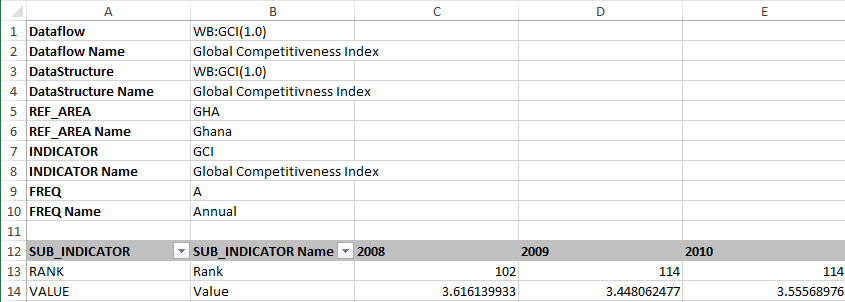Fusion-Excel Default
Jump to navigation
Jump to search
Overview
The Fusion-Excel Data format is not an official SDMX format. It was developed by Metadata Technology prior to SDMX releasing the SDMX-CSV specification. The use case for the Fusion-Excel data format was to provide a simplified data format for data reporters, and data consumers, in a widely used and understood format (Excel).
Fusion-Excel can be used as both an import and export format for the Fusion Registry and Fusion-XL, and an export format for the Fusion Edge Server and Fusion Data Browser.
Formatting Using Query Parameters
The following URL parameters can be used in a RESTful query for to get data in Excel format.
- format=excel
Example
Note: The same formatting can be applied using HTTP Accept Headers as opposed to query parameters.
Format Rules and Restrictions
- Dimensions, Attributes and Time Periods appear as header columns
- If any Dimensions or Attributes have fixed values for the whole dataset, these may be placed in a Header section.
- Multiple Frequencies are supported in the same worksheet (Annual and Monthly for example). In this instance, do not report a value for FREQ, it will be derived from the reported time periods. If a frequency is reported, use the highest frequency reported in the FREQ Dimension.
- It is permissible to have multiple worksheets with data. This mechanism can be used to report different frequencies of data per worksheet. The Header section of each worksheet must be consistent in terms of layout.
- Observation Attributes may be reported in the header section, which is applied as a default value for all observations.
- The header section should be separated from the data section by a blank row
- Reported values appear in the data section
- Dimension values are mandatory. If a value is not reported, this will result in an error.
- Extra rows and columns in the spreadsheet may be added to improve the readability for the user. Blank rows are permitted but with certain restrictions. Blank rows may appear before the header section and between the header section and data section. However, a blank row may not exist within the header section. If a blank row is encountered in the header section, then this is assumed to indicate the end of the header section and this may cause your spreadsheet to be read incorrectly.
- Blank columns indicate that no further information should be read from that row.
- It is permissible to have columns in the data section that are not dimensions, attributes or data but may contain additional information for the reader of the spreadsheet. The image below shows a spreadsheet where column F is for additional notes for each data row. The presence of this column will not prevent the data (in columns G to J) from being read even though the data rows themselves do not have a value for the row
- It is permissible to have rows that do not report any observations. In the image above, row 10 reports no values (cells H10, I10, J10 and K10 are all blank).
